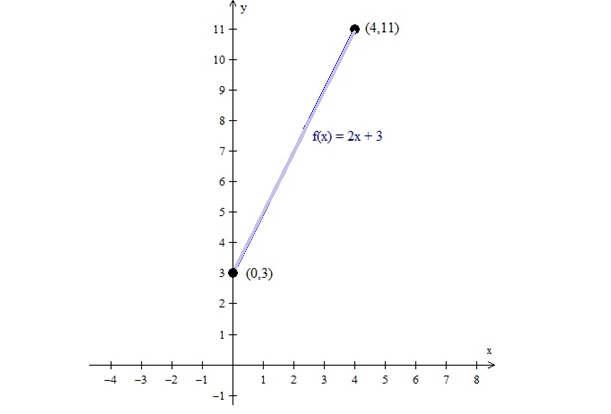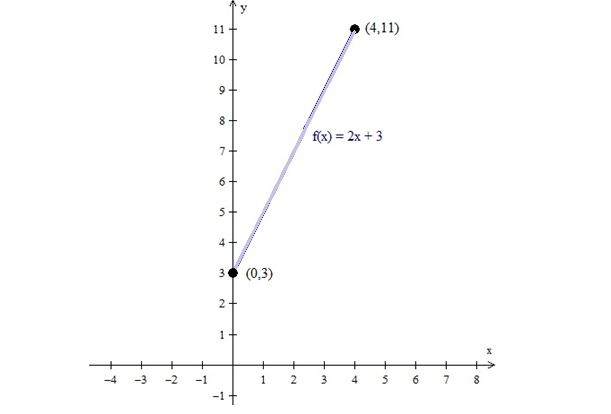
a.
Plot the graph.
a.
Answer to Problem 75RE

Explanation of Solution
Given information:
The function
Graph f.
In (b)-(e), approximate the area
Calculation:
Graph

b.
Partition
b.
Answer to Problem 75RE
Explanation of Solution
Given information:
The function
Partition
Calculation:
Approximate the area
The area under
There are four endpoints used because there are four subintervals within the given interval. First calculate the factor
Hence, partition the interval
Because we’re using the left endpoints of the subintervals.
From the graph we see that
The area under the graph of
c.
Partition
c.
Answer to Problem 75RE
Explanation of Solution
Given information:
The function
Partition
Calculation:
Approximate the area
Since the interval in part (b) was also partitioned into 4 subintervals of equal length we, can again use the fact that
Because we’re using the right endpoints of the subintervals,
From the graph of
The area under the graph of
d.
Partition
d.
Answer to Problem 75RE
Explanation of Solution
Given information:
The function
Partition
Calculation:
First calculate
Partition the interval
Because we’re using the left endpoints of the subintervals,
Hence, the area under the graph of
e.
Partition
e.
Answer to Problem 75RE
Explanation of Solution
Given information:
The function
Partition
Calculation:
Since the interval in part (d) was also partitioned into 8 subintervals of equal length, we can again use the fact that
From the graph of
Hence, the area under the graph of
f.
What is the actual area
f.
Answer to Problem 75RE
Explanation of Solution
Given information:
The function
What is the actual area
Calculation:
The actual area under
Hence, the actual area under
Chapter 14 Solutions
Precalculus
Additional Math Textbook Solutions
Calculus, Single Variable: Early Transcendentals (3rd Edition)
University Calculus: Early Transcendentals (4th Edition)
Precalculus: Concepts Through Functions, A Unit Circle Approach to Trigonometry (4th Edition)
Calculus & Its Applications (14th Edition)
Single Variable Calculus: Early Transcendentals (2nd Edition) - Standalone book
 Calculus: Early TranscendentalsCalculusISBN:9781285741550Author:James StewartPublisher:Cengage Learning
Calculus: Early TranscendentalsCalculusISBN:9781285741550Author:James StewartPublisher:Cengage Learning Thomas' Calculus (14th Edition)CalculusISBN:9780134438986Author:Joel R. Hass, Christopher E. Heil, Maurice D. WeirPublisher:PEARSON
Thomas' Calculus (14th Edition)CalculusISBN:9780134438986Author:Joel R. Hass, Christopher E. Heil, Maurice D. WeirPublisher:PEARSON Calculus: Early Transcendentals (3rd Edition)CalculusISBN:9780134763644Author:William L. Briggs, Lyle Cochran, Bernard Gillett, Eric SchulzPublisher:PEARSON
Calculus: Early Transcendentals (3rd Edition)CalculusISBN:9780134763644Author:William L. Briggs, Lyle Cochran, Bernard Gillett, Eric SchulzPublisher:PEARSON Calculus: Early TranscendentalsCalculusISBN:9781319050740Author:Jon Rogawski, Colin Adams, Robert FranzosaPublisher:W. H. Freeman
Calculus: Early TranscendentalsCalculusISBN:9781319050740Author:Jon Rogawski, Colin Adams, Robert FranzosaPublisher:W. H. Freeman
 Calculus: Early Transcendental FunctionsCalculusISBN:9781337552516Author:Ron Larson, Bruce H. EdwardsPublisher:Cengage Learning
Calculus: Early Transcendental FunctionsCalculusISBN:9781337552516Author:Ron Larson, Bruce H. EdwardsPublisher:Cengage Learning





